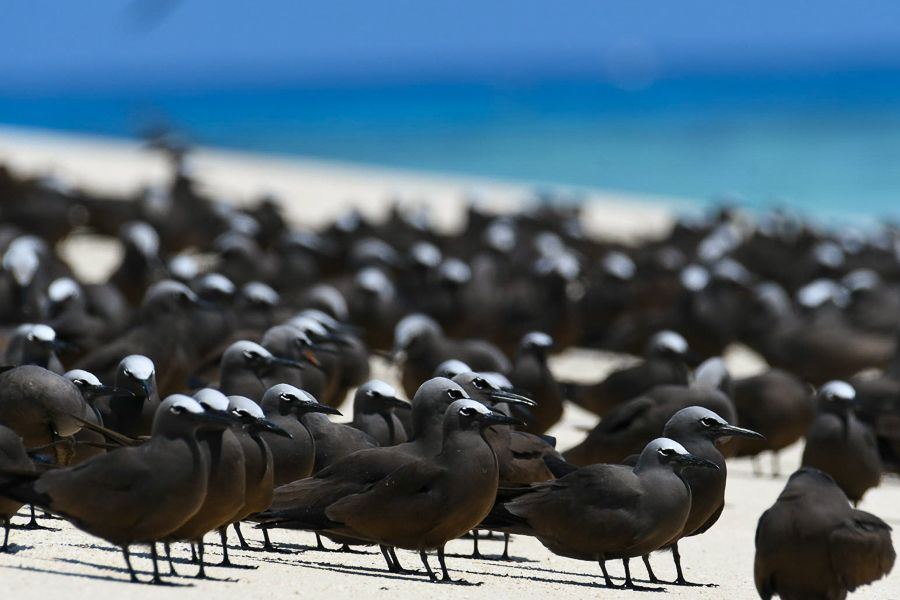Where to See Seabirds on the Great Barrier Reef

Whilst the Great Barrier Reef may be most famous for its underwater inhabitants, the creatures who rule the skies are of equal importance to its abundant and lively ecosystem too. The islands and cays of the Great Barrier Reef provide vital breeding, feeding and migratory grounds for between 1.3 and 1.7 million seabirds, which accounts for around 50 percent of the global population for some of these species! Among the most popular perches for the Great Barrier Reef’s seabirds are Heron Island, Raine Island, Michaelmas Cay and the Swain reefs.
Seabirds’ bodies are designed to excel in their oceanic lifestyles, incorporating waterproof feathers and a built-in desalination system. Their shapes and sizes range from petite builds with long slender wings to rounder bodies with short stumpy wings. The former is more suited to a life of long-distance flights whilst the latter is more likely to stay close to home and make its living off of diving for large schools of prey.
Seabirds live long lives for birds, especially in comparison to smaller species which generally live between 3 and 12 years. The average seabird lives for a minimum of 30 and a maximum of over 50! There really is something to be said for the healing powers of the ocean after all. Most seabirds don’t start reproducing until 5 to 10 years of age, giving them a chance to sync their survival skills to the demands of the sea and prove themselves as worthy breeders of future seafaring generations.
Over 60 percent of the Great Barrier Reef’s seabirds breed on islands and cays in the region. Heron Island brings in around 75,000 black noddies during breeding season, and the Raine Island turtles share their nesting zones with over 17 species of seabirds.
What role do seabirds play in the Great Barrier Reef’s ecosystem?

As nomads of the sky and sea, seabirds play a pivotal role in transferring and distributing seeds, nutrients and organic matter between the land, sea and areas where the land and sea meet (known as intertidal zones). The result of this distribution is a fabulous fertilisation system that boosts and enriches local plant systems. Think of the seabird as an airborne gardening service!
How is the climate crisis impacting the seabirds of the Great Barrier Reef?

Seabirds are one of the world’s most threatened species at present, and according to a study published by the Great Barrier Reef Marine Park Authority, there has been a rapid decline in multiple species’ populations in the area due to plastics, oil and organics pollution and the climate crisis’ impact on oceanography. As the crisis continues to escalate, the successful breeding of seabirds will continue to be drastically impeded. When seabirds detect an increase in the temperature of sea surfaces (resulting in increased difficulty in food foraging) they're more likely to abstain from participation in breeding season.
Current approaches in conserving the Great Barrier Reef’s seabird population consist of conducting further research into solutions and partnering with tourism and fishing parties to raise awareness of the threats climate change poses to their longevity.
Where to watch seabirds on the Great Barrier Reef

Whilst most rookeries (breeding colonies) are closed to the public between the popular mating months of September to March, we reckon your best bet for seabird watching is at Michaelmas Cay. Home to 23 species of bird — including the common noddy, the crested tern and over 30,000 sooty terns — Michaelmas is the most popular and easily accessible seabird hotspot. Nowhere else on the Great Barrier Reef can you see such a diverse range of species mating, nesting and resting in harmony.
Book a day cruise to Michaelmas on Ocean Spirit’s 32-metre catamaran. Spend up to four hours observing the sandy paradise’s magnificent birdlife, snorkelling the turquoise blue waters and sunbathing on the pure white shores as flocks upon flocks of seabirds soar above you.
As there are always up to 20,000 breeding pairs on the cay at any given time, please spectate at a respectful distance and exercise extreme caution when birdwatching as any disturbances can scare away mama and papa birds, leaving their nests vulnerable to predators.














